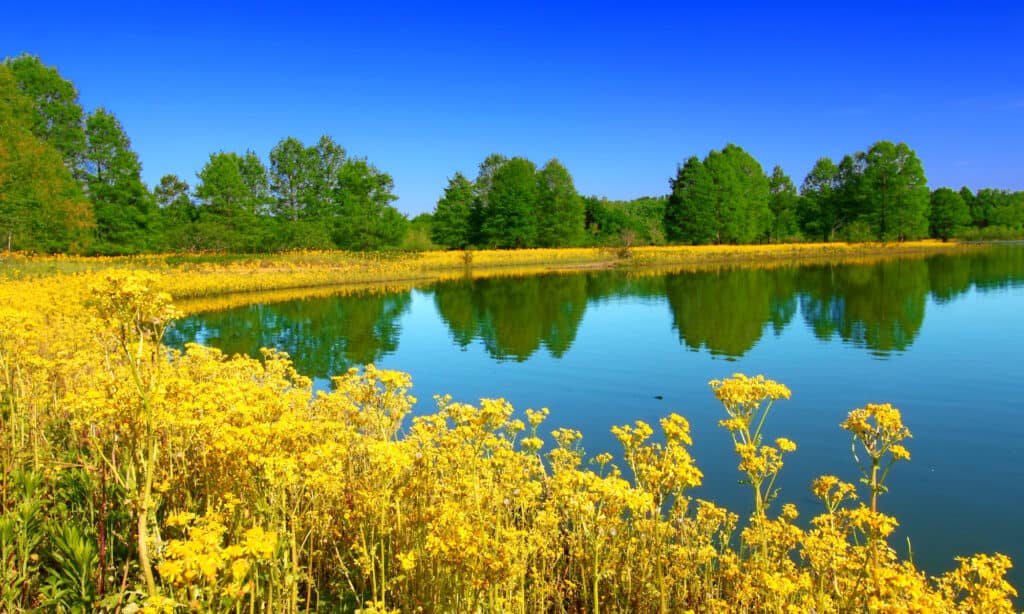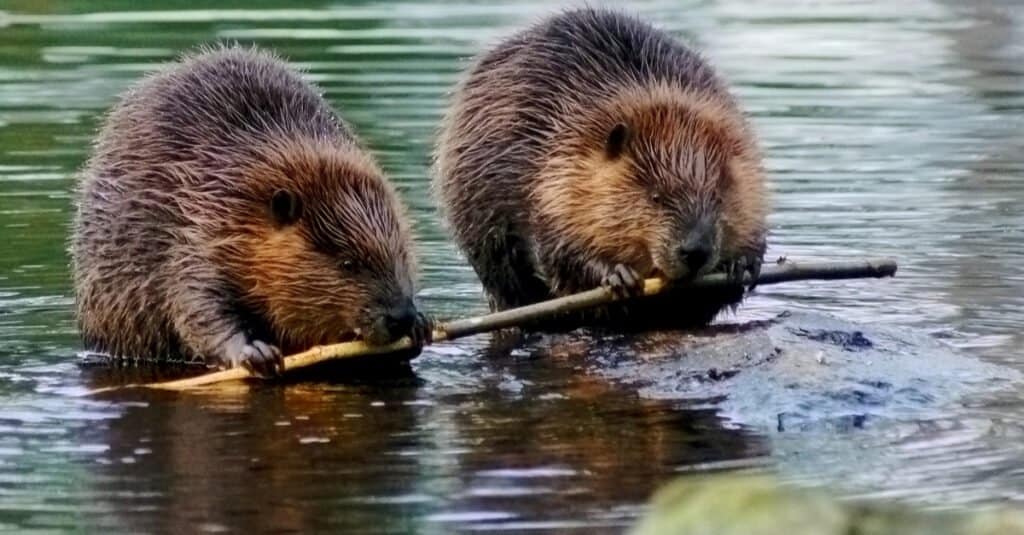Located on the Kaskaskia River, Carlyle Lake is the largest man-made lake in Illinois. Formed in 1967, Carlyle Lake is a freshwater reservoir administered by the U.S. Army Corps of Engineers. The lake encompasses an area of around 26,000 acres or 40.6 square miles. This makes Carlyle Lake not only the largest man-made lake in Illinois but also the largest overall lake in the state. The lake primarily serves as a water storage facility for flood risk management. However, it also serves as a popular recreation area and supports wildlife conservation as well as water quality and supply operations.
Carlyle Lake resides at a surface elevation of 445 feet above sea level. It measures approximately 15 miles long and 3.5 miles wide. That said, a railroad embankment separates the lake into a northern and southern half. The lake features around 85 miles of shoreline. Overall, the lake is rather shallow. On average, most parts of the lake are around 11 feet deep. Meanwhile, the deepest parts of the lake measure around 35 feet deep.
Carlyle Lake continues to provide flood-control risk management for the surrounding counties of Clinton, Fayette, and Bond. It also functions as a popular site for recreational watercraft. Popular activities on the lake include boating, skiing, sailing, and fishing. The lake is also one of Illinois’s top fishing and hunting locations. Anglers come to the lake to catch various gamefish, including bass, catfish, and crappie. Hunters visit the lake to shoot or trap waterbirds and hunt deer and turkeys. Additionally, nature enthusiasts love coming to the lake to watch resident bird species such as eagles, ospreys, and herons.
In this article, you’ll learn all about the history and geography of Carlyle Lake. We’ll also discuss visitors’ positive and negative views of the lake. Get ready to discover the largest man-made lake in Illinois, Carlyle Lake!

Largest Man-Made Lake in Illinois: History of Carlyle Lake

The construction on Carlyle Lake began in October 1958.
©Jason Patrick Ross/Shutterstock.com
Before the Reservoir
Experts estimate that people arrived in the areas now known as Illinois around 12,000 years ago. These nomadic tribes eventually developed unique cultures and identities. Today, we remember the names of some of these tribes, such as the Kaskaskia, Michigamea, Peoria, and Tamaroa. In fact, one of the greatest societies in North American history existed just 20 miles to the west of where Carlyle Lake now resides. At its peak around 1,000 years ago, the city of Cahokia was the largest in the United States. The city covered around 6 square miles and supported a population of around 20,000 people.
The arrival of French explorers in the early 1600s represented a turning point in Illinois’s history. Within the next 200 years, most of the Native tribes in the area disappeared or were driven west. Around 1811 or 1812, John Hall built a log fort and the first houses on the land that would become the town of Carlyle at Carlyle Lake’s southern shore. Over time, the town slowly grew as it attracted more farmers, traders, and merchants. The town’s residents eventually called their settlement Carlyle after the 18th-century English author Thomas Carlyle.
Creation of the Reservoir
Over the next hundred years, Carlyle grew into a bustling trade city on the Kaskaskia River. However, the community faced one persistent problem: flooding. Frequent flooding on the river hampered the community’s development and led to calls for solutions to the problem. In 1933, the citizens of Clinton County got together to discuss the merits of the Kaskaskia River Valley Project. They endeavored to understand everything they could about the Kaskaskia River’s social, economic, and physical aspects. With sufficient information, they submitted a proposal to the United States Congress to form a reservoir at Carlyle to control flooding in the region. Congress approved the citizens’ proposal in 1938 with the passage of the Flood Control Act. However, the onset of World War II delayed the project for almost a decade.
Construction on Carlyle Lake officially began in October 1958. The U.S. government purchased 25,000 acres of land around the Kaskaskia River to prepare for the project. The project required the removal of numerous homesteads, roads, burial mounds, and cemeteries. In addition, the government had to purchase and plug 69 oil wells in the region to prevent these wells from polluting the reservoir. From start to finish, the project took 10 years to complete. Construction wrapped up in April of 1967, and the lake was officially opened on June 3rd of that year.
Where to Find Carlyle Lake on a Map
Carlyle Lake is located in southern Illinois, about 50 miles east of St. Louis, Missouri. It’s situated within Clinton County and covers over 26,000 acres of land and water. To find it on a map, you can search for “Carlyle Lake” or use its coordinates (38°42′45″N 89°23′43″W) to pinpoint its exact location.
If you’re planning a visit to Carlyle Lake from out-of-state or another region in Illinois beyond southern Illinois, there are several major highways that will get you there, including I-70 and I-64. Additionally, if coming from the St.Louis area, take the exit off the interstate highway onto Highway 50 East towards Breese, then turn left on RT127 North and continue until reach Carlyle Dam/Spillway, where the visitors center is located with boat rentals available during the season.
Carlyle Lake Geography

You can find diverse wildlife along the Carlyle Lake shores, including deer, foxes, bobcats, rabbits, and beavers.
©P Harstela/Shutterstock.com
Carlyle Lake resides along the Kaskaskia River in southern Illinois. The river flows into the lake on its northern end and exits via the Carlyle Dam on its southern shores. Several smaller waterways feed into the lake, including Brewster Creek, Coles Creek, Hurricane Creek, and Louse Run. In total, the lake stretches into three different counties, Clinton, Fayette, and Bond.
The U.S. Army Corps of Engineers operates several recreation areas around the lake, including the Dam West, Dam East, Coles Creek, Boulder, and McNair Recreation Areas. Additionally, the Illinois Department of Natural Resources oversees several projects on and around the lake. These include the Eldon Hazlet State Park on its southwestern shore and the Carlyle Lake State Fish & Wildlife Area (SFWA) on the lake’s northern end. The SFWA consists of nearly 9,500 acres of wildlife habitat comprising wetlands, grasslands, woodland, and open water.
The landscape surrounding Carlyle Lake features rolling hills and mixed woodlands. You can find diverse wildlife along its shores, including deer, foxes, bobcats, rabbits, and beavers. You can also find over 350 bird species around Carlyle Lake. Its represented birds include various species of geese, grebes, sandpipers, herons, owls, hawks, flycatchers, sparrows, and warblers. Additionally, Carlyle Lake supports a thriving population of game fish. In its waters, you can find catfish, crappie, bluegill, bass, and sauger.
Carlyle Lake Reviews
Reviews of Carlyle Lake are overwhelmingly positive. Many visitors that come to the lake praise its excellent views. Some people never even step foot on the water, preferring to walk the trails around the lake and catch glimpses of the wildlife in the area. If you like watersports, Carlyle Lake offers plenty of recreational opportunities, including boating, kayaking, canoeing, sailing, and skiing. You can access the lake from numerous boat ramps or one of its five public beaches. Alternatively, you can visit one of the five campgrounds around the lake, which holds over 300 campsites. Carlyle Lake also ranks as one of the top fishing destinations in Illinois. The lake offers excellent fishing for various species, including largemouth bass, channel and flathead catfish, crappie, and bluegill.
That said, not all reviews of Carlyle Lake are positive. Some visitors complain that the water can get very dirty. Some visitors claim that they did not want to get into the water because it was so dirty and that boating on the lake looked hazardous due to floating debris. Additionally, some reviewers have complained that the trails around the lake are poorly marked. Finding a trail map for the area can be difficult, making it easy to get lost. Regardless, most people agree that Carlyle is well worth the visit whether you enjoy fishing, camping, hiking, or simply want to stop and enjoy the scenery.
The photo featured at the top of this post is © Jason Patrick Ross/Shutterstock.com
Thank you for reading! Have some feedback for us? Contact the AZ Animals editorial team.






